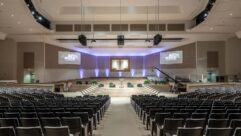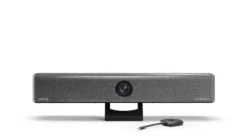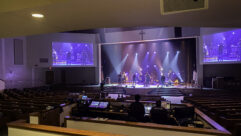
Media for the Message
Jan 1, 2008 12:00 PM,
By Jay Ankeney
Plasma manufacturers on house-of-worship applications.

For a recent installation at Resurrection Life Church in Grandville, Mich., Parkway Electric chose an LG Electronics plasma to give coverage to the seats behind the mix position.
The capital expenditure needed for sophisticated AV installations in houses of worship can take significant funds away from other activities. Increasingly, however, the communication enhancement in the main sanctuary, the lobby, overflow listening areas, and teaching classrooms has led many to conclude the message is worth investing in the media.
In a recent survey, Technologies for Worship Magazine reported, “Out of the house-of-worship respondents, 86 percent indicated that they were interested in purchasing display technology, including digital signage.”
But choosing the right technology can be crucial in maximizing a congregation’s return on its investment. To expand on the Technology Showcase on p. 50 of this issue about plasma screens applicable for the HOW market, representatives from major display manufacturing companies were asked to discuss considerations for installing such technology into worship facilities, and why they feel plasma displays are, in their opinions, currently the best option for many HOW applications.
Participants included Hans Baumann, senior product manager at NEC Display Solutions; Karl DeManss, product manager at Panasonic Professional Display Company; Brian Hale, marketing manager for business solutions products at Pioneer Electronics (USA); and John Holmes, marketing manager, public displays, at Sony Electronics.
Media for the Message
Jan 1, 2008 12:00 PM,
By Jay Ankeney
Plasma manufacturers on house-of-worship applications.
Why should a house of worship choose plasma technology over other flatpanel displays for their installations?
Baumann: There are a few key benefits to using a plasma display versus an LCD in this type of venue. First, you can get larger plasma screen sizes for less money than comparable LCD displays. Also, plasmas have a high viewing angle, meaning that the picture can be seen easily from virtually any angle. In a house of worship, congregation members are sitting in many different positions in reference to the display’s location. Easy viewing with a crystal-clear picture is important for these members, so they can read song lyrics and see videos without trouble.
DeManss: Plasmas have a much faster pixel-response time than LCD, meaning that motion video will appear sharp and clear in motion images, where LCDs tend to blur due to relatively slow response times. Even at 4 milliseconds, the LCD images will blur under certain motion conditions to the extent that even full-HD images in quick motion will appear with sub-SD video-resolution clarity.
There is also longevity to consider. PDPs [plasma display panels] are rated at 60,000 or 100,000 hours, and tend to be more reliable over time. [With] LCDs, while claiming [60,000-hour] durability, these ratings are typically measured in tightly controlled and non-real-world conditions (reduced brightness, running 24/7, etc.) to hide the effects of accelerated aging which occur every time an LCD is turned on or off. Also, as LCDs run at a higher brightness, the typical power supply is designed to maintain the set brightness level by “over driving” the circuits. This will accelerate aging while consuming more power over time.
Hale: Other reasons to choose plasma displays include better color rendition (blacks look black, etc.) and no motion blur on video. Plasma is also power efficient, which is good for houses of worship because it won’t cause an increase in the electric bill. These applications should also be careful to select professional plasmas over consumer plasmas or LCD. The professional plasmas are built to be durable and flexible for multiple applications, while consumer plasmas are built to deliver a high-quality picture within a home theater environment.
Holmes: If the application is the display of schedules, events, images, or windowed video for information and signage purposes, then surely plasma should not be used because of the inherent risk of burn-in. However, if the unit is going to be used exclusively for full-screen video, then plasma is the right choice. While the gap is closing quickly, currently plasma technology still provides a better contrast ratio and better color depth than LCD.
Media for the Message
Jan 1, 2008 12:00 PM,
By Jay Ankeney
Plasma manufacturers on house-of-worship applications.
What makes the process of installing plasma displays in a house of worship different from that for other venues?
Baumann: Sight lines, optimum viewing distance, length of cable runs are all important location considerations. Also, because many houses of worship are older buildings, contractors must be careful in their modifications and stick within local codes. Sometimes, if they do too much, other items must also be brought up to code, which brings up a financial issue. A possible solution to reducing financial expenses is to see if any of the work can be done by congregation members.
DeManss: Considerations for layout and ability for the congregation to view the content in the desired manner (line of sight, number of screens related to screen size, etc). Consultation with the religious leaders is important, as the display technology should be designed to complement their sermons without interfering with the desired impact.
Hale: Houses of worship tend to have more volunteer labor available because of a valued sense of community, but the labor force may not have a specialized knowledge for this type of activity. This means they should look for a plasma display that comes with multiple resources from the manufacturer, such as a detailed owners manual, easy-to-understand technical documentation, and technical support. Most importantly, the plasma display should be compatible with current and existing legacy equipment. When a piece of video equipment breaks, most houses of worship can’t afford to buy a whole new system. They buy products to replace the piece of the puzzle that isn’t working anymore. This means the plasma display needs to work with whatever components it may be asked to interface with.
Holmes: Plasma screens are heavier than other technologies, and care should be taken to make sure they are mounted in accordance with local codes and the rated weight of the display. Typically, safety cables are used to secure a plasma display in case the mount fails.
Media for the Message
Jan 1, 2008 12:00 PM,
By Jay Ankeney
Plasma manufacturers on house-of-worship applications.
How do you integrate the plasma display with audio needs in a house of worship?
Baumann: Audio installations are often challenging in houses of worship due to the acoustics of the venue and the need for the spoken words to be intelligible and yet incorporate the music. This means that, generally, speakers integrated into the display will be inadequate for most installations. Many houses of worship use in-the-ceiling speakers rather than speakers on the display, which aren’t as directional. Since a plasma or LCD is just a receiver of the audio, there are no difficulties integrating it into their audio system, if required.
Hale: The most important feature is flexibility. If one house of worship wants the plasma to have speakers connected to the display, but another house of worship just wants video to be shown, the plasma needs to be flexible enough to meet both sets of demands. The plasma must operate at a very low noise level, but still be able to maintain 24/7/365 use. The display should be able to support attached speakers, as well as external sound systems.
Holmes: If it’s installed in a remote room where a full-screen video feed is provided, then speakers should be added to the display. But generally, sanctuaries have audio reinforcement on a separate system so that the entire area is covered with amplified sound. In this case, speakers on the display are not needed, and may create problems due to various propagation delays throughout the signal paths, which would create an echoing-hall effect. In those situations, it’s better to have a separate, amplified sound system.
Is there much interest in high-definition display capabilities? For what purposes would a house of worship want to invest extra money for HD capabilities?
Baumann: Many houses of worship are beginning to consider HD cameras and video distribution systems, since the trend is continuing to head in that direction. However, there is a significant cost to upgrading to HD to keep in mind. Most current applications — like text, messages, and songs — in houses of worship do not need full HD 1080p resolution. ED [enhanced definition] resolution would be fine in most venues. If, however, HDTV broadcasts are a necessity for the house of worship, high definition would be an advantage.
DeManss: At this time, most video production we have found has been using typical SD-resolution video due to costs of HD video production equipment, so the best match for SD content tends to be 768 panels (1366×768 or 1024×768). This will provide a cost savings to the congregation, while providing excellent image quality by more closely matching the resolution of the content with the panel. As congregations choose to upgrade their video production capabilities to HD quality, the 768 panels will still look good well into the future. The only real consideration would be if the facility had already upgraded the video to 1080 HD quality and panel pricing was less important. Then, 1080p panels would be recommended.
Holmes: Yes. The cost of high-definition camcorders, for example, has dropped to the point that even budget-minded houses of worship can afford HD gear. The display should match the capability of the acquisition system.
Media for the Message
Jan 1, 2008 12:00 PM,
By Jay Ankeney
Plasma manufacturers on house-of-worship applications.
Is security a major concern in house-of-worship installations? If so, what considerations should a contractor keep in mind, and what security solutions are available?
Baumann: Security is a concern in any location. As displays get larger, it is more difficult to simply walk away with them, as they are difficult to conceal. Houses of worship should protect their investment since many times, these displays are purchased with donations. There are many mounts that include security screw designs that require a proprietary tool. Enclosures are another popular way of maintaining security over displays. NEC encourages the use of a Kensington lock device (or comparable) to discourage any wrongdoing.
Hale: Yes, security is a factor. Pioneer Professional Plasmas have features that help with security, such as IR Lock, which disables the use of remote controls. In addition, there is button disable and RS-232 control. The RS-232 control can act as a communication device between the plasma display and the security staff. A signal can be sent to the plasma by security to make sure it is still there, whether the plasma is turned on or not. If security doesn’t receive a signal back, it will know the plasma has been removed. The houses of worship can also purchase special security-mounting hardware that will make it more difficult to remove the plasma from a wall.
Holmes: The use of a security cable [against dropping], and the fact that the mounts are bolted to the wall and the display discourage all but the most ambitious perpetrators of crime. However, Sony has a full line of security cameras and recording technology, which are commonly used in the house-of-worship market for a variety of reasons, including theft deterrence.










